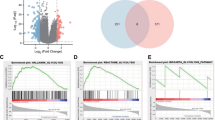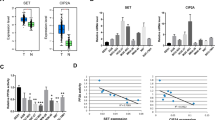Abstract
PDZ and LIM domain protein 1 (PDLIM1) is a cytoskeletal protein and is associated with the malignant pathological features of several tumors. However, the prognostic value of PDLIM1 and the molecular mechanisms by which it is involved in the metabolism and progression in gastric cancer (GC) are still unclear. The GEPIA database was used to predict the expression and prognosis of PDLIM1 in GC. qRT-PCR and western blot assays were applied to detect the mRNA and protein expression in GC tissues and cells. Loss- and gain-of-function experiments were performed to evaluate the biological role of PDLIM1 in GC cells. The Warburg effect was detected by a battery of glycolytic indicators. The interaction of PDLIM1 and hexokinase 2 (HK2) was determined by a co-immunoprecipitation assay. Furthermore, the modulatory effects of PDLIM1 and HK2 on Wnt/β-catenin signaling were assessed. The results showed that PDLIM1 expression was upregulated in GC tissues and cells and was associated with a poor prognosis for GC patients. PDLIM1 inhibition reduced GC cell proliferation, migration and invasion and promoted cell apoptosis. In the glucose deprivation (GLU-D) condition, the PDLIM1 level was reduced and PDLIM1 overexpression led to an increase in glycolysis. Besides, mechanistic investigation showed that PDLIM1 interacted with HK2 to mediate biological behaviors and the glycolysis of GC through Wnt/β-catenin signaling under glucose deprivation. In conclusion, PDLIM1 interacts with HK2 to promote gastric cancer progression by enhancing the Warburg effect via Wnt/β-catenin signaling.





Similar content being viewed by others
Availability of data and material
All datasets for this study are included in the manuscript files.
References
Backert S, Schmidt TP, Harrer A, Wessler S (2017) Exploiting the gastric epithelial barrier: Helicobacter pylori’s attack on tight and adherens junctions. Curr Top Microbiol Immunol 400:195–226
Bauer K, Kratzer M, Otte M, Quintana KD, Hagmann J, Arnold GJ, Eckerskorn C, Lottspeich F, Siess W (2000) Human CLP36, a PDZ-domain and LIM-domain protein, binds to α-actinin-1 and associates with actin filaments and stress fibers in activated platelets and endothelial cells. Blood 96(13):4236–4245
Chen HN, Yuan K, Xie N, Wang K, Huang Z, Chen Y, Dou Q, Wu M, Nice EC, Zhou ZG, Huang C (2016) PDLIM1 stabilizes the E-cadherin/β-catenin complex to prevent epithelial-mesenchymal transition and metastatic potential of colorectal cancer cells. Cancer Res 76(5):1122–1134
Garcia SN, Guedes RC, Marques MM (2019) Unlocking the potential of HK2 in cancer metabolism and therapeutics. Curr Med Chem 26(41):7285–7322
Gonzalez-Menendez P, Hevia D, Alonso-Arias R, Alvarez-Artime A, Rodriguez-Garcia A, Kinet S, Gonzalez-Pola I, Taylor N, Mayo JC, Sainz RM (2018) GLUT1 protects prostate cancer cells from glucose deprivation-induced oxidative stress. Redox Biol 17:112–127
Guo Q, Xu J, Huang Z, Yao Q, Chen F, Liu H, Zhang Z, Lin J (2021) ADMA mediates gastric cancer cell migration and invasion via Wnt/β-catenin signaling pathway. Clin Transl Oncol 23(2):325–334
Hasegawa T, Ohno K, Funahashi S, Miyazaki K, Sato K (2010) CLP36 interacts with palladin in dorsal root ganglion neurons. Neurosci Lett 476(2):53–57
Heallen T, Zhang M, Wang J, Bontlla-Claudio M, Klysik E, Ohnson RL, Martin JF (2011) Hippo pathway inhibits Wnt signaling to restrain cardiomyocyte proliferation and heart size. Science 332(6028):458–461
Hong C, Zhuang H, Cai B, Chen J, Huang S, Fang T (2021) β-elemene attenuates fibrosis after esophageal endoscopic submucosal dissection modulating the HIF-1α/HK2/p38-MAPK signaling axis. ACS Biomater Sci Eng 7(7):3399–3408
Hu Q, Qin Y, Zhang B, Liang C, Ji S, Shi S, Xu W, Xiang J, Liang D, Ni Q, Yu X, Xu J (2017) FBW7 increases the chemosensitivity of pancreatic cancer cells to gemcitabine through upregulation of ENT1. Oncol Rep 38(4):2069–2077
Huang Z, Zhou JK, Wang K, Chen H, Qin S, Liu J, Luo M, Chen Y, Jiang J, Zhou L, Zhu L, He J, Li J, Pu W, Gong Y, Li J, Ye Q, Dong D, Hu H, Zhou Z, Dai L, Huang C, Wei X, Peng Y (2020) PDLIM1 inhibits tumor metastasis through activating hippo signaling in hepatocellular carcinoma. Hepatology 71(5):1643–1659
Joshi SS, Badgwell BD (2021) Current treatment and recent progress in gastric cancer. CA Cancer J Clin 71(3):264–279
Li H, Lei B, Xiang W, Wang H, Feng W, Liu Y, Qi S (2017) Differences in protein expression between the U251 and U87 cell lines. Turk Neurosurg 27(6):894–903
Li K, Zhang A, Li X, Zhang H, Zhao L (2021) Advances in clinical immunotherapy for gastric cancer. Biochim Biophys Acta Rev Cancer 1876(2):188615
Li LM, Luo FJ, Song X (2020a) MicroRNA-370-3p inhibits cell proliferation and induces chronic myelogenous leukaemia cell apoptosis by suppressing PDLIM1/Wnt/β-catenin signaling. Neoplasma 67(3):509–518
Li N, Lu N, Xie C (2019) The Hippo and Wnt signalling pathways: crosstalk during neoplastic progression in gastrointestinal tissue. FEBS J 286(19):3745–3756
Li R, Li P, Wang J, Liu J (2020b) STIP1 down-regulation inhibits glycolysis by suppressing PKM2 and LDHA and inactivating the Wnt/β-catenin pathway in cervical carcinoma cells. Life Sci 258:118190
Liang Y, Rao Z, Du D, Wang Y, Fang T (2023) Butyrate prevents the migration and invasion, and aerobic glycolysis in gastric cancer via inhibiting Wnt/β-catenin/c-Myc signaling. Drug Dev Res 84(3):532–541
Liberti MV, Locasale JW (2016) The Warburg effect: how does it benefit cancer cells? Trends Biochem Sci 41(3):211–218
Liu X, Zuo X, Sun X, Tian X, Teng Y (2022) Hexokinase 2 promotes cell proliferation and tumor formation through the Wnt/β-catenin pathway-mediated cyclin D1/c-myc upregulation in epithelial ovarian cancer. J Cancer 13(8):2559–2569
Liu Z, Zhan Y, Tu Y, Chen K, Liu Z, Wu C (2015) PDZ and LIM domain protein 1(PDLIM1)/CLP36 promotes breast cancer cell migration, invasion and metastasis through interaction with α-actinin. Oncogene 34(10):1300–1311
Loong JH, Wong TL, Tong M, Sharma R, Zhou L, Ng KY, Yu HJ, Li CH, Man K, Lo CM, Guan XY, Lee TK, Yun JP, Ma SK (2021) Glucose deprivation-induced aberrant FUT1-mediated fucosylation drives cancer stemness in hepatocellular carcinoma. J Clin Invest 131(11):e143377
Mathupala SP, Ko YH, Pedersen PL (2006) Hexokinase II: cancer’s double-edged sword acting as both facilitator and gatekeeper of malignancy when bound to mitochondria. Oncogene 25(34):4777–4786
Naegle KM, White FM, Lauffenburger DA, Yaffe MB (2012) Robust co-regulation of tyrosine phosphorylation sites on proteins reveals novel protein interactions. Mol BioSyst 8(10):2771–2782
Okrah EA, Wang Q, Fu H, Chen Q, Gao J (2020) PdpaMn inhibits fatty acid synthase-mediated glycolysis by down-regulating PI3K/Akt signaling pathway in breast cancer. Anticancer Drugs 31(10):1046–1056
Ono R, Kaisho T, Tanaka T (2015) PDLIM1 inhibits NF-κB-mediated inflammatory signaling by sequestering the p65 subunit of NF-κB in the cytoplasm. Sci Rep 5:18327
Piao S, Zheng L, Zheng H, Zhou M, Feng Q, Zhou S, Ke M, Yang H, Wang X (2022) High expression of PDLIM2 predicts a poor prognosis in prostate cancer and is correlated with epithelial-mesenchymal transition and immune cell infiltration. J Immunol Res 2022:2922832
Sharma P, Shathasivam T, Ignatchenko V, Kislinger T, Gramolini AO (2011) Identification of an FHL1 protein complex containing ACTN1, ACTN4, and PDLIM1 using affinity purifications and MS-based protein–protein interaction analysis. Mol Biosyst 7(4):1185–1196
Shi T, Ma Y, Cao L, Zhan S, Xu Y, Fu F, Liu C, Zhang G, Wang Z, Wang R, Lu H, Lu B, Chen W, Zhang X (2019) B7–H3 promotes aerobic glycolysis and chemoresistance in colorectal cancer cells by regulating HK2. Cell Death Dis 10(4):308
Sousa BC, Ahmed T, Dann WL, Ashman J, Guy A, Durand T, Pitt AR, Spickett CM (2019) Short-chain lipid peroxidation products form covalent adducts with pyruvate kinase and inhibit its activity in vitro and in breast cancer cells. Free Radic Biol Med 144:223–233
Sung H, Ferlay J, Siegel RL, Laversanne M, Soerjomataram I, Jemal A, Bray F (2021) Global cancer statistics 2020: GLOBOCAN estimates of incidence and mortality worldwide for 36 cancers in 185 countries. CA Cancer J Clin 71(3):209–249
Tian S, Peng P, Li J, Deng H, Zhan N, Zeng Z, Dong W (2020) SERPINH1 regulates EMT and gastric cancer metastasis via the Wnt/β-catenin signaling pathway. Aging (Albany NY) 12(4):3574–3593
Vallée A, Lecarpentier Y, Guillevin R, Vallée JN (2017) Aerobic glycolysis hypothesis through WNT/beta-catenin pathway in exudative age-related macular degeneration. J Mol Neurosci 62(3–4):368–379
Wan W, Long Y, Jin X, Li Q, Wan W, Liu H, Zhu Y (2021) Protective role of microRNA-200a in diabetic retinopathy through downregulation of PDLIM1. J Inflamm Res 14:2411–2424
Wang H, Wang X, Xu L, Lin Y, Zhang J, Cao H (2021) Low expression of CDHR1 is an independent unfavorable prognostic factor in glioma. J Cancer 12(17):5193–5205
Wang P, Cong M, Liu T, Li Y, Liu L, Sun S, Sun L, Zhu Z, Ma H, You H, Zhang H, Jia J (2020a) FoxA2 inhibits the proliferation of hepatic progenitor cells by reducing PI3K/Akt/HK2-mediated glycolysis. J Cell Physiol 235(12):9524–9537
Wang Y, Xian H, Qi J, Wei F, Cheng X, Li S, Wang Q, Liu Z, Yu Y, Zhou J, Sun X, Liu H, Wei Y (2020b) Inhibition of glycolysis ameliorate arthritis in adjuvant arthritis rats by inhibiting synoviocyte activation through AMPK/NF-кB pathway. Inflamm Res 69(6):569–578
Zhang M, Liu T, Sun H, Weng W, Zhang Q, Liu C, Han Y, Sheng W (2018) Pim1 supports human colorectal cancer growth during glucose deprivation by enhancing the Warburg effect. Cancer Sci 109(5):1468–1479
Zhao Y, Song Y, Zhao R, Zhao M, Huang Q (2020) Gene panel of persister cells as a prognostic indicator for tumor repopulation after radiation. Front Oncol 10:607727
Zhou JK, Fan X, Cheng J, Liu W, Peng Y (2021) PDLIM1: Structure, function and implication in cancer. Cell Stress 5(8):119–127
Zou Y, Du Y, Cheng C, Deng X, Shi Z, Lu X, Hu H, Qiu J, Jiang W (2021) FAT10 promotes the progression of bladder cancer by upregulating HK2 through the EGFR/AKT pathway. Exp Cell Res 398(1):112401
Funding
None.
Author information
Authors and Affiliations
Contributions
Guan Li: Conceptualization, Writing- Reviewing and Editing. Yunpeng Lei: Data curation, Writing- Original draft preparation. Lirui He: Visualization, Investigation. Yue Li: Supervision. Jianing Hou: Methodology, Software. Haoran Zhang: Software, Validation.
Corresponding author
Ethics declarations
Ethics approval
This retrospective study was approved by the Ethics Committee of Peking University Shenzhen Hospital and conducted with the guide of the Declaration of Helsinki. All patients signed an informed consent form according to the standard process. All collected tissues were immediately refrigerated for subsequent experiments.
Conflicts of interests
The authors declare that they have no competing interests.
Additional information
Publisher's Note
Springer Nature remains neutral with regard to jurisdictional claims in published maps and institutional affiliations.
Highlights
PDLIM1 expression was upregulated in GC tissues and cells, and was associated with poor prognosis of GC patients.
PDLIM1 inhibition inhibited GC cell proliferation, migration and invasion, and promoted cell apoptosis.
In the glucose deprivation condition, the PDLIM1 level was declined and PDLIM1 overexpression led to an increase in glycolysis.
PDLIM1 interacts with HK2 to promote gastric cancer progression through enhancing the Warburg effect via Wnt/β-catenin signaling.
Rights and permissions
Springer Nature or its licensor (e.g. a society or other partner) holds exclusive rights to this article under a publishing agreement with the author(s) or other rightsholder(s); author self-archiving of the accepted manuscript version of this article is solely governed by the terms of such publishing agreement and applicable law.
About this article
Cite this article
Lei, Y., He, L., Li, Y. et al. PDLIM1 interacts with HK2 to promote gastric cancer progression through enhancing the Warburg effect via Wnt/β-catenin signaling. Cell Tissue Res 395, 105–116 (2024). https://doi.org/10.1007/s00441-023-03840-z
Received:
Accepted:
Published:
Issue Date:
DOI: https://doi.org/10.1007/s00441-023-03840-z




